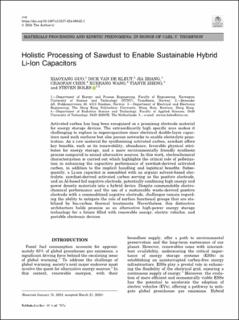| dc.contributor.author | Guo, Xiaoyang | |
| dc.contributor.author | van de Kleut, Dick | |
| dc.contributor.author | Zhang, Jia | |
| dc.contributor.author | Chen, Chaofan | |
| dc.contributor.author | Wang, Xuehang | |
| dc.contributor.author | Zheng, Tianye | |
| dc.contributor.author | Boles, Steven Tyler | |
| dc.date.accessioned | 2024-04-24T08:26:12Z | |
| dc.date.available | 2024-04-24T08:26:12Z | |
| dc.date.created | 2024-04-19T10:21:23Z | |
| dc.date.issued | 2024 | |
| dc.identifier.issn | 1047-4838 | |
| dc.identifier.uri | https://hdl.handle.net/11250/3127870 | |
| dc.description.abstract | Activated carbon has long been recognized as a promising electrode material for energy storage devices. The extraordinarily high specific area makes it challenging to replace in supercapacitors since electrical double-layer capacitors need such surfaces but also porous networks to enable electrolyte penetration. As a raw material for synthesizing activated carbon, sawdust offers key benefits, such as its renewability, abundance, favorable physical attributes for energy storage, and a more environmentally friendly synthesis process compared to mined alternative sources. In this work, electrochemical characterization is carried out which highlights the critical role of pelletization in enhancing the capacitive performance of sawdust-derived activated carbon, in addition to the implicit handling and logistical benefits. Subsequently, a Li-ion capacitor is assembled with an organic solvent-based electrolyte, sawdust-derived activated carbon serving as the positive electrode, and an Al-based foil negative electrode, potentially combining high energy and power density materials into a hybrid device. Despite commendable electrochemical performance and the use of a sustainable waste-derived positive electrode with a commoditized negative electrode, challenges remain regarding the ability to mitigate the role of surface functional groups that are stabilized by bio-carbon thermal treatments. Nevertheless, this distinctive architecture holds promise as an alternative high-power energy storage technology for a future filled with renewable energy, electric vehicles, and portable electronic devices. | en_US |
| dc.description.abstract | Holistic Processing of Sawdust to Enable Sustainable Hybrid Li-Ion Capacitors | en_US |
| dc.language.iso | eng | en_US |
| dc.publisher | Springer | en_US |
| dc.rights | Navngivelse 4.0 Internasjonal | * |
| dc.rights.uri | http://creativecommons.org/licenses/by/4.0/deed.no | * |
| dc.title | Holistic Processing of Sawdust to Enable Sustainable Hybrid Li-Ion Capacitors | en_US |
| dc.title.alternative | Holistic Processing of Sawdust to Enable Sustainable Hybrid Li-Ion Capacitors | en_US |
| dc.type | Peer reviewed | en_US |
| dc.type | Journal article | en_US |
| dc.description.version | publishedVersion | en_US |
| dc.source.journal | JOM | en_US |
| dc.identifier.doi | 10.1007/s11837-024-06542-1 | |
| dc.identifier.cristin | 2262973 | |
| dc.relation.project | Norges forskningsråd: 332081 | en_US |
| cristin.ispublished | true | |
| cristin.fulltext | original | |
| cristin.qualitycode | 1 | |

